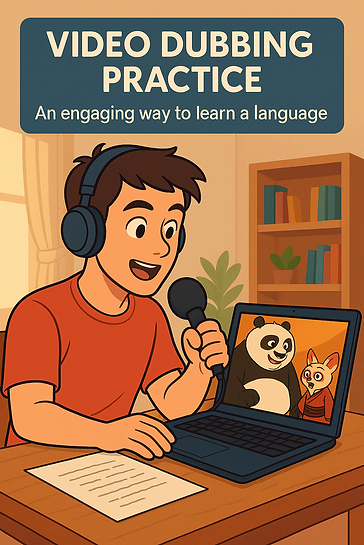
Video Dubbing Module Reflection

1. Language Improvement and Student Engagement
2. Peer Support, Personal Growth, and ChatGPT
3. Future Classroom Application
4. Conclusion and Reflection
Language Improvement and Student Engagement
The video dubbing activity was a highly effective way to improve second language skills, particularly pronunciation, fluency, and confidence in speaking. Besides these benefits, the activity also encouraged collaboration and increased student engagement. One reason it was so engaging is that we could select video clips that we liked personally, which made the task more enjoyable and interesting. Compared to textbook dialogues, the lines in the clips felt much closer to how English is spoken in real life. This made the language more authentic and practical to everyday situations. Moreover, dubbing the conversations from movies and animations, we were learning how to use English naturally, with emotion, tone, and rhythm. This approach helped turn language learning into something fun and meaningful, rather than just another meaningless academy.

Peer Support, Personal Growth, and ChatGPT
Collaboration with group members played a key role in my oral development. Through peer evaluation, I was able to receive constructive feedback from a third-person perspective. This helped me notice drawback that I might have overlooked on my own. For example, I was chosen to dub Po from Kung Fu Panda. Po is a very outgoing character who often uses sounds to express his feelings. As someone who is shy, I had difficulty matching his energetic tone. Besides, one particular line was spoken very quickly, and I couldn’t pronounce it clearly no matter how many times I tried. My group members were very patient and supportive, and they even practiced the lines with me, gave me suggestions for better pronunciation, and helped me gain more confidence.
For ChatGPT, it helped me translate subtitles, rehearse lines, and even suggested how to adjust intonation to sound more natural. I also use online dictionary to check out the pronunciation of words. Using online tools didn’t distract my learning, it actually enhanced it, because it allowed me to get quick feedback and try out different ways of expressing the same lines. I was responsible for the largest portion of the dubbing in our group, which made me feel a lot of pressure—especially because we had to perform the dubbing live in front of the class. Knowing that all eyes would be on me added to my anxiety, and I didn’t want to let my group down. Because of this, I spent a long time preparing and practicing my lines. I listened to the original voice over and repeated the lines over and over, trying to match the character’s timing, rhythm, and emotion. Through this process, I also became more aware of intonations, and I learned how the pronunciation of certain words changes depending on their part of speech. For example, the word “project” as a noun versus a verb.

Future Classroom Aplication
After this experience, I definitely plan to use video dubbing in my future English teaching. I’ve realized that many students, myself included, often learn English as an academic subject rather than as a tool for communication. Dubbing offers a way to change this mindset. It encourages students to engage with language in a fun, interactive, and creative way. They get to act, perform, and use English for real communication. It’s also an opportunity to help students to learn real-life materials, such as conversational phrases, slang, or cultural expressions, which are often missing from school’s textbooks. I believe that video dubbing can be an excellent in-class activity, because it combines listening, speaking, and even an enhancement of self-confidence.


Conclusion and Reflection
Overall, the dubbing project was both challenging and fulfilling. The most difficult phase was trying to match the character’s speed and emotional tone, especially when the dialogue moved quickly. However, it was also in this challenge that I grew the most. By pushing myself out of my comfort zone and practicing repeatedly, I became more comfortable with speaking English. This experience showed me how creative and collaborative tasks can lead to meaningful language learning. Whether as a learner or a future teacher, I see great potential in dubbing as a tool to develop speaking skills, build confidence, and make learning English more enjoyable.